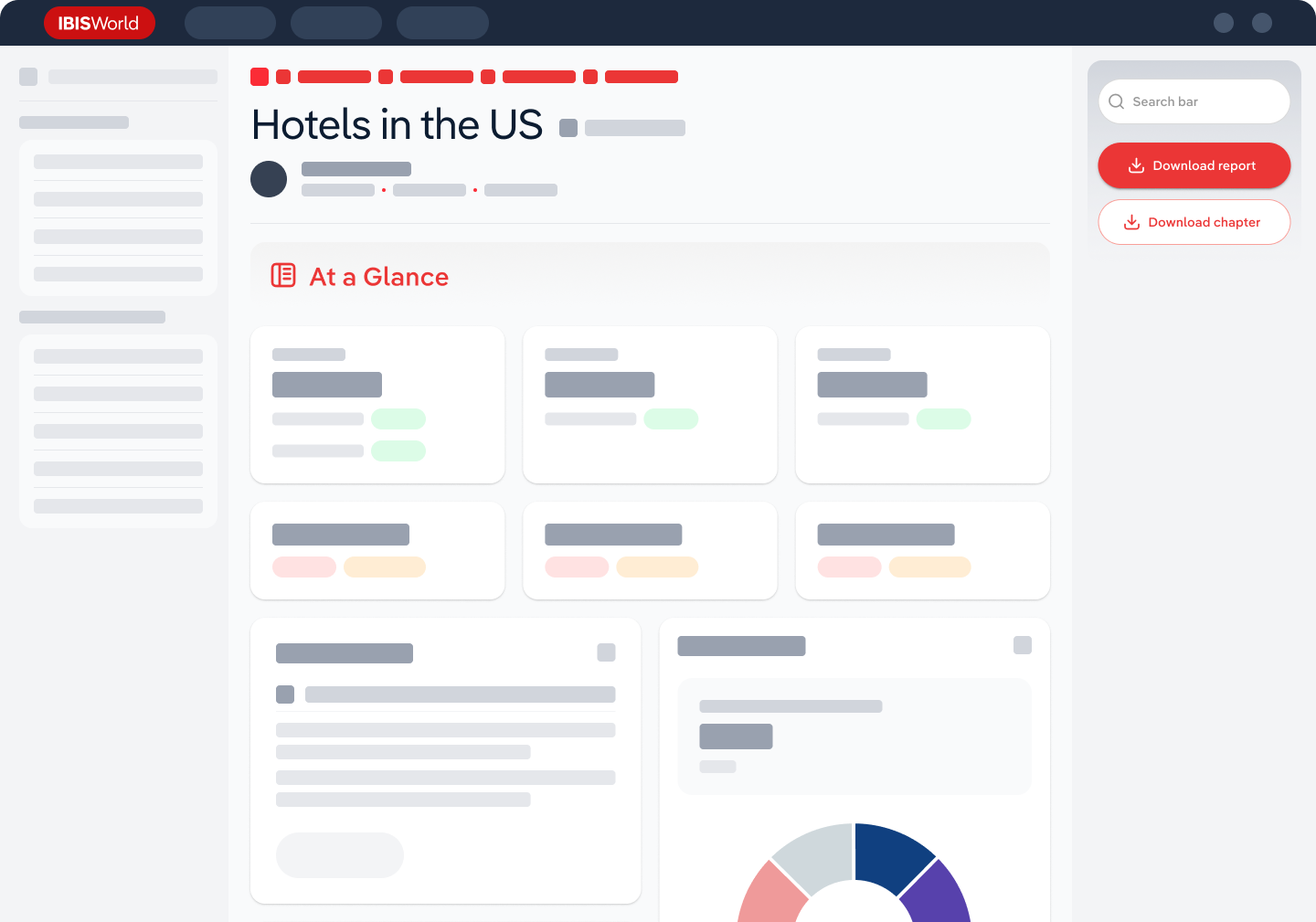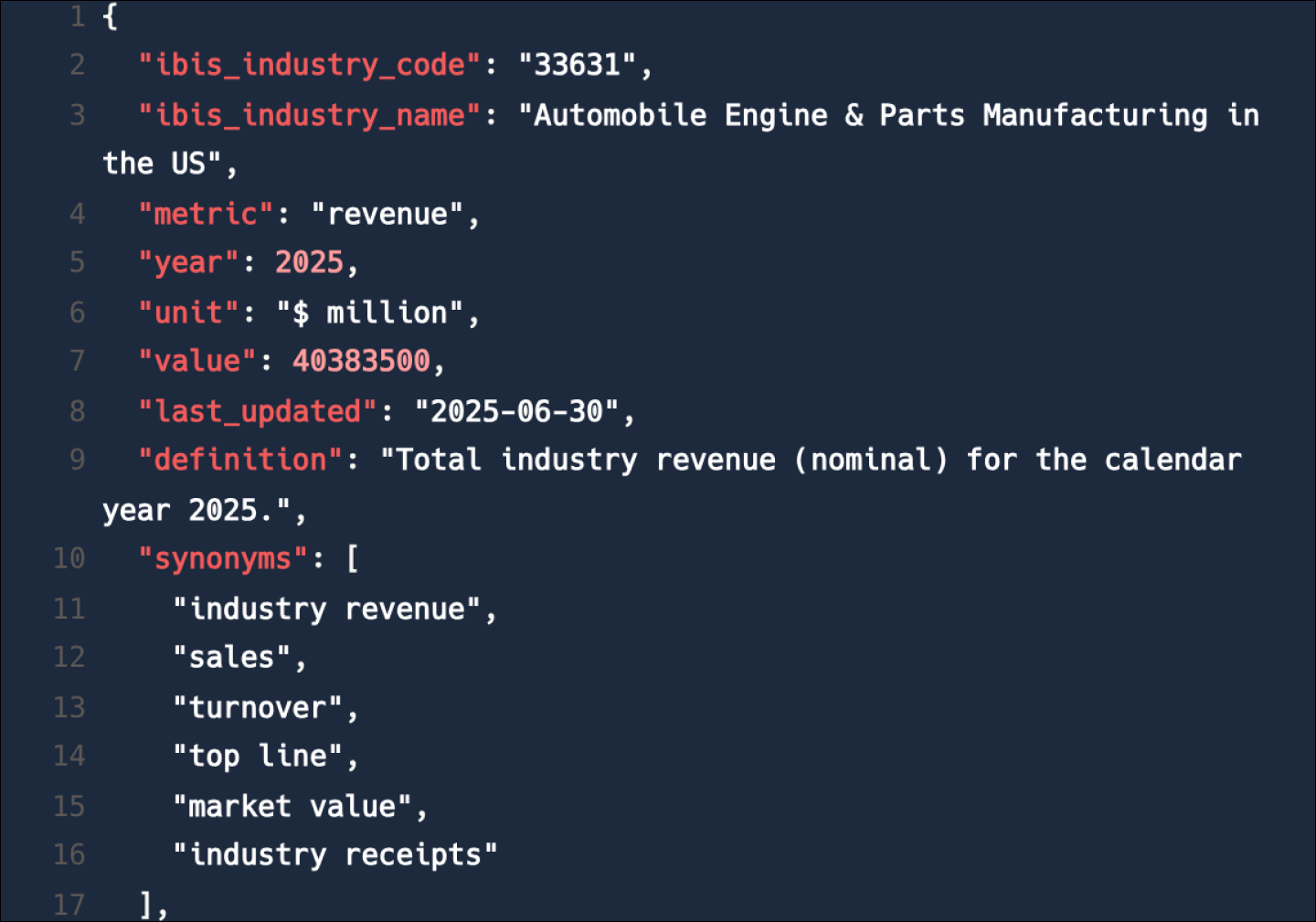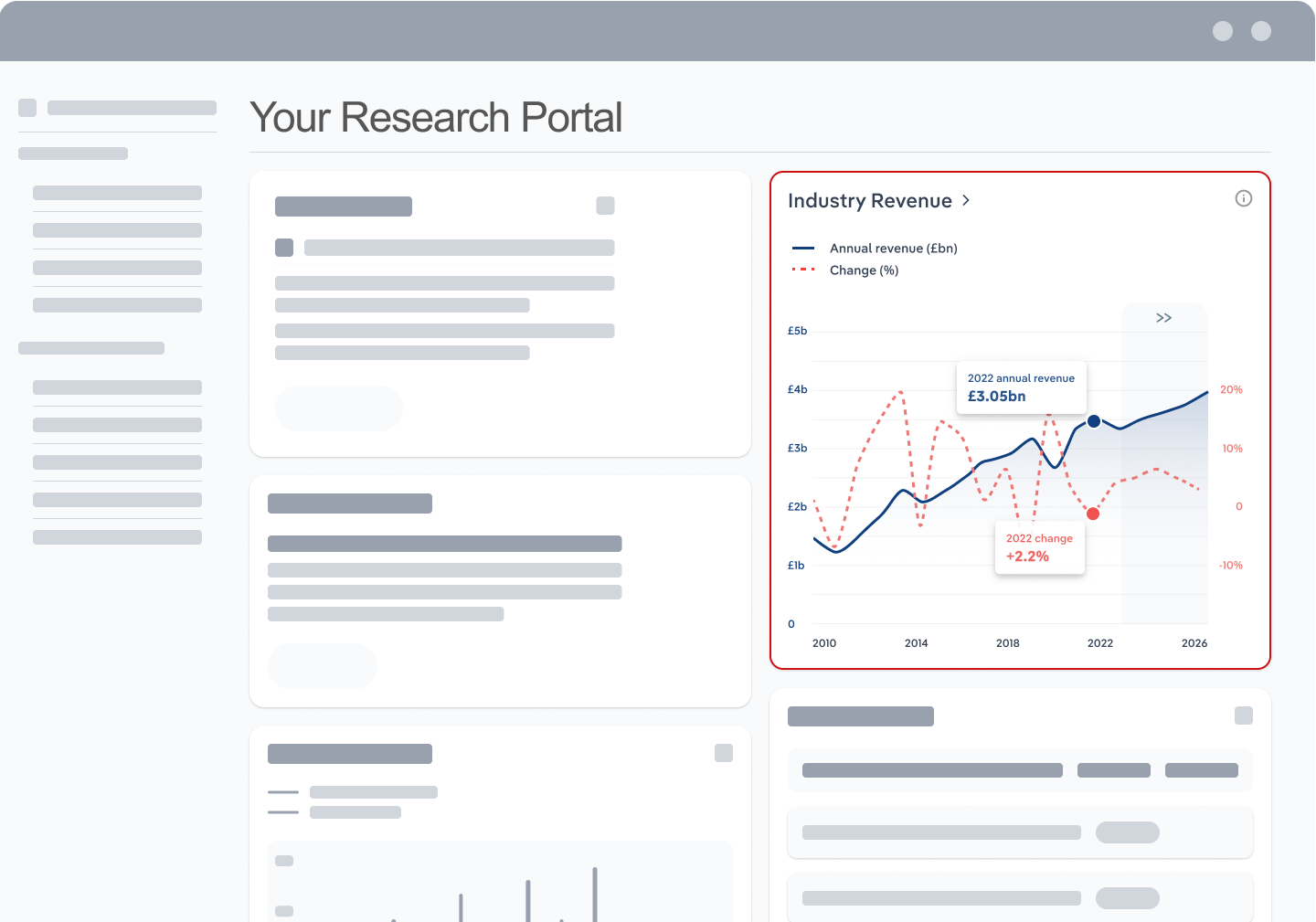Industry Statistics and Trends
Market size and recent performance (2015-2030)
Industry revenue has declined at a CAGR of 3.2 % over the past five years, to reach an estimated £2.2bn in 2025.
Trends and Insights
A change in living arrangements is shifting demand to more adaptable rugs and curtains
- The growing number of single-adult households has cut the size of the average UK home. The number has been growing because of delayed marriages, higher divorce rates and individual lifestyle choices. According to the ONS, approximately 8.4 million people lived alone in the UK in 2023, accounting for 30% of all households. The UK's ageing population means most single-person households stem from Britons aged 65 years and over. Single-person households often live in smaller homes or flats, meaning consumer demand shifts towards smaller-sized carpets or rugs, lowering demand for products like carpets.
- Additional trends and insights available with purchase
Industry outlook (2025-2030)
Market size is projected to grow over the next five years.
Trends and Insights
Government housebuilding policies boost demand, yet targets may be missed, challenging retailers
- The UK government has implemented several policies to speed up housebuilding and increase the number of new homes. In December 2024, the government announced it aims to build 1.5 million homes in England by 2029. To support this legislation, in May 2025, the Deputy Prime Minister announced that developers could face fines if they fall 10% or more behind on agreed schedules without a valid reason. More new homes will drive demand for home furnishings, including carpets, rugs and curtains, presenting significant revenue opportunities for retailers.
Biggest companies in the Carpet, Rug & Curtain Retailers in the UK
| Company | Market Share (%)
2026 | Revenue (£m)
2026 |
|---|---|---|
Tapi Carpets & Floors Ltd | 353.6 | |
Carpetright Ltd | 340.0 | |
United Carpets Group Ltd | 28.0 |
To view the market share and analysis for all 4 top companies in this industry, view purchase options.
Products & Services Segmentation
Industry revenue is measured across several distinct product and services lines, including Tufted carpet, Curtains and window dressings and Floor coverings. Tufted carpet is the largest segment of the Carpet, Rug & Curtain Retailers in the UK.
Trends and Insights
Changing tastes help edge up demand for tufted carpets
- Tufted carpet is popular with households because it's durable, long-lasting, available in a wide range of colours and styles and cheaper than hardwood floors.
- More insights available in the full report
Table of Contents
About this industry
Industry definition
Businesses within this industry specialise in the retail of an extensive selection of home furnishings, including an array of carpets, rugs, curtains and various wall and floor coverings. They offer these products to consumers through dedicated stores equipped to cater to a variety of interior decoration needs and preferences.
What's included in this industry?
Products and services covered in the Carpet, Rug & Curtain Retailers industry in the United Kingdom include Tufted carpet, Curtains, Window dressings, Floor coverings, Rugs and Needlepoint carpets.Companies
Companies covered in the Carpet, Rug & Curtain Retailers industry in the United Kingdom include Tapi Carpets & Floors Ltd, Carpetright Ltd and United Carpets Group Ltd.Purchase this report to view all 4 major companies in this industry.
Related Terms
Related terms covered in the Carpet, Rug & Curtain Retailers industry in the United Kingdom include tufted carpet, needlepoint carpet and company voluntary agreement (cva).Industry Code
SIC 47.53 - Carpet, Rug & Curtain Retailers in the UK
Performance
Get an indication of the industry's health through historical, current and forward-looking trends in the performance indicators that make or break businesses.
Analyst insights
Generation renters prefer rugs over carpets and other permanent flooring. They aren’t willing to invest big sums in decorating a property they don’t own, preferring smaller p...
In this chapter (4)
- Current Performance
- Outlook
- Volatility
- Life Cycle
Key metrics
- Annual Revenue, Recent Growth, Forecast, Revenue Volatility
- Number of Employees, Recent Growth, Forecast, Employees per Business, Revenue per Employee
- Number of Businesses, Recent Growth, Forecast, Employees per Business, Revenue per Business
- Total Profit, Profit Margin, Profit per Business
Charts
- Revenue, including historical (2015-2024) and forecast (2025-2030)
- Employees, including historical (2015-2024) and forecast (2025-2030)
- Businesses, including historical (2015-2024) and forecast (2025-2030)
- Profit, including historical (2015-2025)
- Industry Volatility vs. Revenue Growth
- Industry Life Cycle
Detailed analysis
- Trends in supply, demand and current events that are driving current industry performance
- Expected trends, economic factors and ongoing events that drive the industry's outlook
- Key success factors for businesses to overcome volatility
- How contribution to GDP, industry saturation, innovation, consolidation, and technology and systems influence the industry's life cycle phase.
Products and Markets
Learn about an industry's products and services, markets and trends in international trade.
Analyst insight
Low prices benefit floor coverings. As consumers' real disposable incomes have been eroding, due to high inflation amid the cost-of-living crisis, the high-quality, low-price...
In this chapter
- Products & Services
- Major Markets
Key metrics
- Largest market segment and value in 2025
- Product innovation level
Charts
- Products & services segmentation in 2025
- Major market segmentation in 2025
Detailed analysis
- Trends impacting the recent performance of the industry's various segments
- Innovations in the industry's product or service offering, specialization or delivery method
- Key factors that successful businesses consider in their offerings
- Buying segments and key trends influencing demand for industry products and services
Geographic Breakdown
Discover where business activity is most concentrated in an industry and the factors driving these trends to find opportunities and conduct regional benchmarking.
Analyst insights
Higher disposable incomes draw retailers to the South East. The region’s residents have more money to spend on carpets, curtains and rugs than anywhere else, except London.
In this chapter (1)
- Business Locations
Charts
- Share of revenue, establishment, wages and employment in each region
- Share of population compared to establishments in each region in 2025
Tables
- Number and share of establishments in each region in 2025
- Number and share of revenue each region accounts for in 2025
- Number and share of wages each region accounts for in 2025
- Number and share of employees in each region in 2025
Detailed analysis
- Geographic spread of the industry across Europe, and trends associated with changes in the business landscape
- Key success factors for businesses to use location to their advantage
Competitive Forces
Get data and insights on what's driving competition in an industry and the challenges industry operators and new entrants may face, with analysis built around Porter's Five Forces framework.
Analyst insights
Other retailers increasingly encroach on the market. Carpet, rug and curtain retailers face stiff competition from department stores and large homeware stores (think IKEA and...
In this chapter (4)
- Concentration
- Barriers to Entry
- Substitutes
- Buyer & Supplier Analysis
Key metrics
- Industry concentration level
- Industry competition level and trend
- Barriers to entry level and trend
- Substitutes level and trend
- Buyer power level and trend
- Supplier power level and trend
Charts
- Market share concentration among the top 4 suppliers from 2020-2025
- Supply chain including upstream supplying industries and downstream buying industries, flow chart
Detailed analysis
- Factors impacting the industry’s level of concentration, such as business distribution, new entrants, or merger and acquisition activity.
- Key success factors for businesses to manage the competitive environment of the industry.
- Challenges that potential industry entrants face such as legal, start-up costs, differentiation, labor/capital intensity and capital expenses.
- Key success factors for potential entrants to overcome barriers to entry.
- Competitive threats from potential substitutes for the industry’s own products and services.
- Key success factors for how successful businesses can compete with substitutes.
- Advantages that buyers have to keep favorable purchasing conditions.
- Advantages that suppliers have to maintain favorable selling conditions.
- Key success factors for how businesses can navigate buyer and supplier power.
Companies
Learn about the performance of the top companies in the industry.
Analyst insights
Carpetright enters administration. Due to falling consumer spending, a significant cyberattack and mounting debts, it entered administration in July 2024. Major rival Tapi Ca...
In this chapter
- Market Share Concentration
- Companies
- Company Spotlights
Charts
- Industry market share by company in 2021 through 2025
- Major companies in the industry, including market share, revenue, profit and profit margin in 2025
- Overview of Tapi Carpets & Floors Ltd's performance by revenue, market share and profit margin from 2019 through 2025
- Overview of Carpetright Ltd's performance by revenue, market share and profit margin from 2019 through 2025
- Overview of United Carpets Group Ltd's performance by revenue, market share and profit margin from 2019 through 2025
- Overview of revenue, market share and profit margin trend for one additional company
Detailed analysis
- Description and key data for Tapi Carpets & Floors Ltd, and factors influencing its performance in the industry
- Description and key data for Carpetright Ltd, and factors influencing its performance in the industry
- Description and key data for United Carpets Group Ltd, and factors influencing its performance in the industry
- Description, key data and performance trends for one additional company
External Environment
Understand the demographic, economic and regulatory factors that shape how businesses in an industry perform.
Analyst insights
There’s no regulation specific to carpet and curtain retailers. They only have to keep an eye on general consumer protection laws, like the Consumer Rights Act and the Consum...
In this chapter
- External Drivers
- Regulation & Policy
- Assistance
Key metrics
- Regulation & policy level and trend
- Assistance level and trend
Charts
- Regulation & Policy historical data and forecast (2015-2030)
- Assistance historical data and forecast (2015-2030)
Detailed analysis
- Demographic and macroeconomic factors influencing the industry, including Regulation & Policy and Assistance
- Major types of regulations, regulatory bodies, industry standards or specific regulations impacting requirements for industry operators
- Key governmental and non-governmental groups or policies that may provide some relief for industry operators.
Financial Benchmarks
View average costs for industry operators and compare financial data against an industry's financial benchmarks over time.
Analyst insights
Higher costs eat into profit. Retailers struggled with higher shipping and purchase costs in 2023-24. However, since then, profit margin has inched up thanks to inflation edg...
In this chapter
- Cost Structure
- Financial Ratios
- Key Ratios
Key metrics
- Profit margin, and how it compares to the sector-wide margin
- Average wages, and how it compares to the sector-wide average wage
- Largest cost component as a percentage of revenue
- Industry average ratios for days' receivables, industry coverage and debt-to-net-worth ratio
Charts
- Average industry operating costs as a share of revenue, including purchases, wages, depreciation, utilities, rent, other costs and profit in 2025
- Average sector operating costs as a share of revenue, including purchases, wages, depreciation, utilities, rent, other costs and profit in 2025
- Investment vs. share of economy
Data tables
- Liquidity Ratios (2019-2023)
- Coverage Ratios (2019-2023)
- Leverage Ratios (2019-2023)
- Operating Ratios (2019-2023)
- Assets (2019-2023)
- Liabilities (2019-2023)
- Cash Flow & Debt Service Ratios (2015-2030)
- Revenue per Employee (2015-2030)
- Revenue per Enterprise (2015-2030)
- Employees per Establishment (2015-2030)
- Employees per Enterprise (2015-2030)
- Average Wage (2015-2030)
- Wages/Revenue (2015-2030)
- Establishments per Enterprise (2015-2030)
- IVA/Revenue (2015-2030)
- Imports/Demand (2015-2030)
- Exports/Revenue (2015-2030)
Detailed analysis
- Trends in the cost component for industry operators and their impact on industry costs and profitability
Key Statistics
Industry Data
Data Tables
Including values and annual change:
- Revenue (2015-2030)
- IVA (2015-2030)
- Establishments (2015-2030)
- Enterprises (2015-2030)
- Employment (2015-2030)
- Exports (2015-2030)
- Imports (2015-2030)
- Wages (2015-2030)
Top Questions Answered
Unlock comprehensive answers and precise data upon purchase. View purchase options.
What is the market size of the Carpet, Rug & Curtain Retailers industry in the United Kingdom in 2025?
The market size of the Carpet, Rug & Curtain Retailers industry in the United Kingdom is £2.2bn in 2025.
How many businesses are there in the Carpet, Rug & Curtain Retailers industry in the United Kingdom in 2025?
There are 3,832 businesses in the Carpet, Rug & Curtain Retailers industry in the United Kingdom, which has grown at a CAGR of 0.2 % between 2020 and 2025.
How may import tariffs affect the Carpet, Rug & Curtain Retailers industry in the United Kingdom?
The Carpet, Rug & Curtain Retailers industry in the United Kingdom is unlikely to be materially impacted by import tariffs with imports accounting for a low share of industry revenue.
How may export tariffs affect the Carpet, Rug & Curtain Retailers industry in the United Kingdom?
The Carpet, Rug & Curtain Retailers industry in the United Kingdom is unlikely to be materially impacted by export tariffs with exports accounting for a low share of industry revenue.
Has the Carpet, Rug & Curtain Retailers industry in the United Kingdom grown or declined over the past 5 years?
The market size of the Carpet, Rug & Curtain Retailers industry in the United Kingdom has been declining at a CAGR of 3.2 % between 2020 and 2025.
What is the forecast growth of the Carpet, Rug & Curtain Retailers industry in the United Kingdom over the next 5 years?
Over the next five years, the Carpet, Rug & Curtain Retailers industry in the United Kingdom is expected to grow.
What are the biggest companies in the Carpet, Rug & Curtain Retailers industry in the United Kingdom?
The biggest companies operating in the Carpet, Rug & Curtain Retailers industry in the United Kingdom are Tapi Carpets & Floors Ltd, Carpetright Ltd and United Carpets Group Ltd
What does the Carpet, Rug & Curtain Retailers industry in the United Kingdom include?
Tufted carpet and Curtains are part of the Carpet, Rug & Curtain Retailers industry in the United Kingdom.
Which companies have the highest market share in the Carpet, Rug & Curtain Retailers industry in the United Kingdom?
The company holding the most market share in the Carpet, Rug & Curtain Retailers industry in the United Kingdom is Tapi Carpets & Floors Ltd.
How competitive is the Carpet, Rug & Curtain Retailers industry in the United Kingdom?
The level of competition is moderate and increasing in the Carpet, Rug & Curtain Retailers industry in the United Kingdom.
Methodology
How are IBISWorld reports created?
IBISWorld has been a leading provider of trusted industry research for over 50 years to the most successful companies worldwide. With offices in Australia, the United States, the United Kingdom, Germany and China, we are proud to have local teams of analysts that conduct research, data analysis and forecasting to produce data-driven industry reports.
Our analysts start with official, verified and publicly available sources of data to build the most accurate picture of each industry. Analysts then leverage their expertise and knowledge of the local markets to synthesize trends into digestible content for IBISWorld readers. Finally, each report is reviewed by one of IBISWorld’s editors, who provide quality assurance to ensure accuracy and readability.
IBISWorld relies on human-verified data and human-written analysis to compile each standard industry report. We do not use generative AI tools to write insights, although members can choose to leverage AI-based tools within the platform to generate additional analysis formats.
What data sources do IBISWorld analysts use?
Each industry report incorporates data and research from government databases, industry-specific sources, industry contacts, and our own proprietary database of statistics and analysis to provide balanced, independent and accurate insights.
Key data sources in the UK include:
- Office for National Statistics
- Office for Budget Responsibility
- Bank of England
Analysts also use industry specific sources to complement catch-all sources, although their perspective may focus on a particular organization or representative body, rather than a clear overview of all industry operations. However, when balanced against other perspectives, industry-specific sources provide insights into industry trends.
These sources include:
- Industry and trade associations
- Industry federations or regulators
- Major industry players annual or quarterly filings
Finally, IBISWorld’s global data scientists maintain a proprietary database of macroeconomic and demand drivers, which our analysts use to help inform industry data and trends. They also maintain a database of statistics and analysis on thousands of industries, which has been built over our more than 50-year history and offers comprehensive insights into long-term trends.
How does IBISWorld forecast its data?
IBISWorld’s analysts and data scientists use the sources above to create forecasts for our proprietary datasets and industry statistics. Depending on the dataset, they may use regression analysis, multivariate analysis, time-series analysis or exponential smoothing techniques to project future data for the industry or driver. Additionally, analysts will leverage their local knowledge of industry operating and regulatory conditions to impart their best judgment on the forecast model.
IBISWorld prides itself on being a trusted, independent source of data, with over 50 years of experience building and maintaining rich datasets and forecasting tools. We are proud to be the keystone source of industry information for thousands of companies across the world.
Learn more about our methodology and data sourcing on the Help Center.










